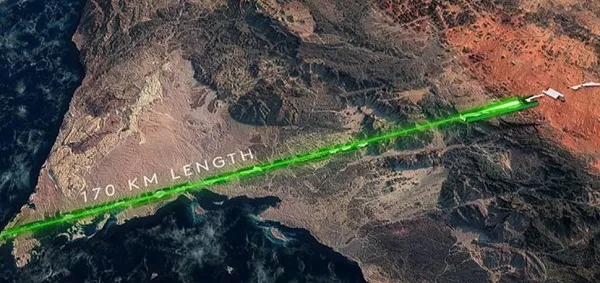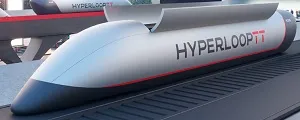
NEOM is a daring and audacious vision of a New Future, a human development accelerator that will embody the future of corporate innovation, livability, and sustainability. NEOM is an initiative of the Public Investment Fund. Saudi Arabia is constructing Neom, a futuristic mega-city amid the Red Sea desert. The state has pledged at least $500 billion and is seeking more investment. The Wall Street Journal got blueprints that describe outlandish designs for artificial rain, a synthetic moon, robotic maids, and hologram teachers. Which will be 33 times the size of New York City, according to Saudi Arabia.

The general explanation is as follows: NEOM is a projected futuristic city in Saudi Arabia's Tabuk Province near the Red Sea. The Crown Prince of Saudi Arabia: Mohammed bin Salman intends to develop this new city in the desert as a future utopia that incorporates the greatest features of modern city living convenience, sustainability, and community, while leaving the bad (traffic, pollution, trash, and insecure water sources) behind. This metropolis will be shaped like a long, thin line. All utilities and care required by people will be easily available within the city. The outdoors will also be conveniently accessible. NEOM's big aim is to establish an urban oasis where mankind and environment can coexist peacefully, rather than an ever-expanding suburban city that encroaches on the natural world surrounding it.

Neom is located in northwestern Saudi Arabia and covers around 10,200 square miles (26,500 square kilometers). This area is roughly the size of Albania. The territory is surrounded to the south by the Red Sea and to the west by the Gulf of Aqaba. Neom will be made up of ten initiatives known as regions. So far, information on four of the regions has been released. The most well-known of these are The Line, Oxagon, Trojena, and Sindalah.

The Line is a 170-kilometer-long linear city that will house nine million people. It will span the Neom area from east to west. The metropolis, according to the developer, will consist of two parallel, 500-meter-high, linear skyscrapers 200 meters apart. The facades of the buildings will be reflected. Oxagon is envisioned as an octagon-shaped port city on the Red Sea in the far south of the Neom area. The port and logistics hub will be the "world's largest floating structure," according to Neom's creator.
Trojena is a projected ski resort in the Sarwat Mountains, near the Neom area. The 60-square-kilometer skiing and outdoor-activity resort will be open all year and will host the Asian Winter Games in 2029.
Sindalah is envisioned as a Red Sea island resort. The 840,000-square-metre island, aimed at the yachting community, would include an 86-berth marina and multiple hotels.
Neom is working on ambitious timetables, with the majority of the project expected to be completed by 2030. Drone footage of site preparation for The Line was released last year, and Neom recently released a video showing glimpses of work on the site. The Sindalah luxury island is the first to be completed, with the developer of Neom planning to welcome its first guests in early 2024.
Neom is intended to address some of the most critical global concerns confronting metropolitan regions while also inspiring a new way of life. The city will conserve 95% of the natural environment surrounding the site, emphasizing humanity's link with the natural world. Neom will be powered entirely by renewable energy sources such as sun, wind, and hydrogen, resulting in a zero-emission, carbon-positive ecosystem. Neom, according to those behind the project, will be a regional powerhouse in water production and storage, based on water desalination. High-tech, interoperable, modular solutions will entice water-related research firms and start-ups to promote innovation and leadership across all areas of the water business. Neom's water distribution network will be totally linked with cutting-edge infrastructure. This will result in minimum water loss, putting Neom at the cutting edge of water technology.

The idea behind NEOM and its line design is to create the world's first zero-impact city. This is, of course, impossible because all development has an environmental consequence. NEOM has the ability to demonstrate the most cutting-edge technology and concepts in passive building design – structures that generate all of their own energy and do not rely on "the grid." Because of its line design, it might also serve as a model for maintaining a city's natural environs. The NEOM project will be built in the desert of northwest Saudi Arabia. According to its website, NEOM intends to create its own water by employing cutting-edge desalination procedures that convert saltwater into drinkable water. The city's designers hope to store water above ground and avoid the dangers of water shortages that have plagued large cities in locations such as the American West as they face increased drought due to climate change. It remains to be seen whether NEOM's proposal will succeed.

As part of its ambition to be a self-sustaining metropolis, NEOM's architecture includes provisions for food growing. Food will be diversified and wholesome, according to the website's depiction of how residents and tourists would be served. Everything will be cultivated organically and without pesticides, employing high-tech greenhouses, aquaculture facilities, and a self-labeled "food park," adding up to adequate food production for a thriving metropolis, according to the website. NEOM intends to provide a paradigm for how cities of the future might be developed and built responsibly by using renewable energy, passive building design, and producing as little waste as possible. Observing the city's growth will undoubtedly be an interesting experience.




